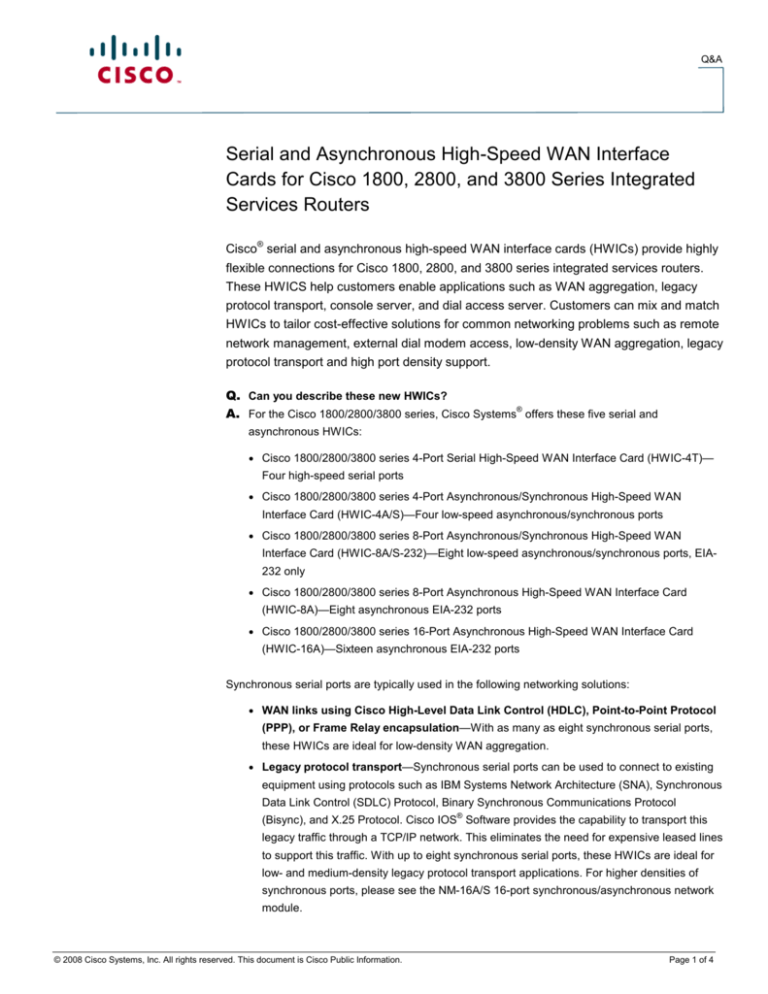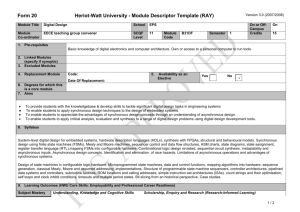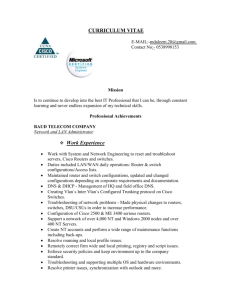
Q&A
Serial and Asynchronous High-Speed WAN Interface
Cards for Cisco 1800, 2800, and 3800 Series Integrated
Services Routers
®
Cisco serial and asynchronous high-speed WAN interface cards (HWICs) provide highly
flexible connections for Cisco 1800, 2800, and 3800 series integrated services routers.
These HWICS help customers enable applications such as WAN aggregation, legacy
protocol transport, console server, and dial access server. Customers can mix and match
HWICs to tailor cost-effective solutions for common networking problems such as remote
network management, external dial modem access, low-density WAN aggregation, legacy
protocol transport and high port density support.
Q. Can you describe these new HWICs?
A. For the Cisco 1800/2800/3800 series, Cisco Systems® offers these five serial and
asynchronous HWICs:
●
Cisco 1800/2800/3800 series 4-Port Serial High-Speed WAN Interface Card (HWIC-4T)—
Four high-speed serial ports
●
Cisco 1800/2800/3800 series 4-Port Asynchronous/Synchronous High-Speed WAN
Interface Card (HWIC-4A/S)—Four low-speed asynchronous/synchronous ports
●
Cisco 1800/2800/3800 series 8-Port Asynchronous/Synchronous High-Speed WAN
Interface Card (HWIC-8A/S-232)—Eight low-speed asynchronous/synchronous ports, EIA232 only
●
Cisco 1800/2800/3800 series 8-Port Asynchronous High-Speed WAN Interface Card
(HWIC-8A)—Eight asynchronous EIA-232 ports
●
Cisco 1800/2800/3800 series 16-Port Asynchronous High-Speed WAN Interface Card
(HWIC-16A)—Sixteen asynchronous EIA-232 ports
Synchronous serial ports are typically used in the following networking solutions:
●
WAN links using Cisco High-Level Data Link Control (HDLC), Point-to-Point Protocol
(PPP), or Frame Relay encapsulation—With as many as eight synchronous serial ports,
these HWICs are ideal for low-density WAN aggregation.
●
Legacy protocol transport—Synchronous serial ports can be used to connect to existing
equipment using protocols such as IBM Systems Network Architecture (SNA), Synchronous
Data Link Control (SDLC) Protocol, Binary Synchronous Communications Protocol
®
(Bisync), and X.25 Protocol. Cisco IOS Software provides the capability to transport this
legacy traffic through a TCP/IP network. This eliminates the need for expensive leased lines
to support this traffic. With up to eight synchronous serial ports, these HWICs are ideal for
low- and medium-density legacy protocol transport applications. For higher densities of
synchronous ports, please see the NM-16A/S 16-port synchronous/asynchronous network
module.
© 2008 Cisco Systems, Inc. All rights reserved. This document is Cisco Public Information.
Page 1 of 4
Q&A
Asynchronous ports are typically used in the following solutions:
●
Console server and terminal server—This solution allows the Cisco integrated services
router to connect to the console or craft ports of other networking equipment to provide
access to the console or craft ports from anywhere in the network. This is ideal for remote
management of equipment in network installations. Cisco IOS Software provides a rich set
of security features to help ensure that only authorized personnel can access these ports.
●
Dial access server—An integrated services router with asynchronous ports can connect to
external modems to provide a dial access server. This provides low-density dial-in access
to the network. For a dial access server solution with integrated modems, please see the 8port and 16-port analog modem network modules.
Q. Can different ports on one HWIC be used for different applications?
A. Yes.
Q. Which connectors and cabling are used with these serial HWICs?
A. The HWIC-4T and HWIC-4A/S use the same Cisco Smart Serial connectors and cabling that
are used on the WIC-2T and WIC-2A/S. The HWIC-8A/S-232, HWIC-8A, and HWIC-16A use
a new high-density connector and corresponding new cables.
On the HWIC-8A/S-232, each connector supports four asynchronous/synchronous ports. See
Table 1 for the available cables.
Table 1.
High-Density Synchronous/Asynchronous Cabling
Product Number
Cable Type
Length
Connector Type
CAB-HD4-232FC
4-port EIA-232 DCE
10 ft (3m)
Female DB-25
CAB-HD4-232MT
4-port EIA-232 DTE
10 ft (3m)
Male DB-25
The HWIC-8A/S and HWIC-16A connectors support eight asynchronous ports per connector. The
Cisco asynchronous cable has the high-density connector on one end and eight RJ-45 plugs on
the other. Connections to other equipment are made using RJ-45 to DB-25 adapters. See Table 2
for the available cables.
Table 2.
High-Density Asynchronous Cabling
Product Number
Cable Type
Length
Connector Type
CAB-HD8-ASYNC
8-port EIA-232
10 ft (3m)
RJ-45
CAB-HD8-KIT
8-port EIA-232 plus eight CAB25AS-MMOD
10 ft (3m)
Male DB-25
CAB-25AS-MMOD
RJ-45 to DB-25 adapter
N/A
Male DB-25
CAB-25AS-FDTE
RJ-45 to DB-25 adapter
N/A
Female DB-25
Q. What are the maximum speeds supported on the HWIC interfaces?
A. The HWIC-4T supports up to 8 Mbps on each port. The HWIC-4A/S and HWIC-8A/S-232
support up to 252 kbps on each port. All five HWICs support asynchronous speeds up to
230.4 kbps.
Q. Can the HWIC-4T run at 8 Mbps on all four ports?
A. Yes.
© 2008 Cisco Systems, Inc. All rights reserved. This document is Cisco Public Information.
Page 2 of 4
Q&A
Q. Can the integrated services routers run four HWIC-4Ts all at 8 Mbps on every port?
A. Yes. The configuration is limited only by the total system throughput and number of available
HWIC slots.
Q. Which routers support these HWICs?
A. These HWICs are supported on all Cisco 1800, 2800, and 3800 series integrated services
routers with HWIC slots. The HWIC-4T and HWIC-16A are not supported on the 1800 Series.
Q. Are these HWICs supported on the Cisco 1600, 1700, 2600, 3600, or 3700 Series?
A. No.
Q. Why is “-232” in the product number for HWIC-8A/S-232?
A. The HWIC-8A/S-232 supports EIA-232 only in the data terminal equipment (DTE) or data
communications equipment (DCE) mode. It does not support EIA-449, EIA-530, EIA-530A,
V.35, or X.21.
Q. Which protocols are supported by the HWIC-4T and HWIC-4A/S?
A. EIA-232, EIA-449, V.35, and X.21 in DTE or DCE mode and EIA-530 and EIA-530A in DTE
mode.
Q. Are any features missing from these HWICs?
A. No support is available for the Airline Product Set (ALPS). For ALPS support, please use the
NM-4A/S, NM-8A/S, or NM-16A/S.
Q. Do these HWICs offer any new features?
A. Yes, the following are new features:
●
More ports in the HWIC form factor
●
The ability to measure the incoming clock rate of synchronous ports in DTE mode (see the
Cisco IOS Software show controller command)
●
Higher synchronous speeds up to 252 kbps on synchronous/asynchronous ports (HWIC4A/S, HWIC-8A/S-232)
●
Higher asynchronous speeds up to 230.4 kbps
●
Support for the lead manipulation feature
Q. What is the “lead manipulation” feature?
A. Lead manipulation is a Cisco IOS Software feature that allows a user to ignore input signals
on the physical interface, view the state of the input signals, and to monitor the transitions of
the input signals.
Ignoring Input Signals
By default, Cisco IOS Software requires some of the input leads on the physical interface to be
asserted. With lead manipulation, the user can configure the serial interface to ignore input
signals. The syntax is shown in Table 3.
Table 3.
Lead Manipulation
Mode
Required Input Leads
DTE
CTS, DCD, DSR
[no] ignore {cts | dcd | dsr}
DCE
RTS, DTR
[no] ignore {dtr | local-loopback | rts}
© 2008 Cisco Systems, Inc. All rights reserved. This document is Cisco Public Information.
Syntax To Ignore Input Leads
Page 3 of 4
Q&A
Viewing the State of Input Signals
Cisco IOS Software will display the state of input signals on the physical interface using show
commands:
●
For serial interfaces configured for synchronous communication, issue the Cisco IOS
Software show interface command.
●
For serial interfaces configured for asynchronous communication, issue the Cisco IOS
Software show line command.
Monitoring Input Signal Transition
Cisco IOS Software introduces new debugging commands to monitor lead transitions on the
physical interface. A user may enable debugging of lead transitions with the [no] debug
serial lead-transitions [serial slot/port] command.
Q. Are cable management solutions available for asynchronous ports?
A. Components Express Inc. offers patch panel solutions for the HWIC-8A and HWIC-16A.
These patch panels connect to the high-density asynchronous connectors and break out into
individual RJ-45 jacks for each asynchronous port. For more information, contact Components
Express at:
Components Express Inc.
10330 Argonne Woods Drive, Suite 100
Woodridge, IL 60517-4995
Phone: 630 257-0605 / 800 578-6695 (outside Illinois)
Fax: 630 257-0603
Web: http://www.componentsexpress.com/
Printed in USA
© 2008 Cisco Systems, Inc. All rights reserved. This document is Cisco Public Information.
C67-466096-01 07/08
Page 4 of 4









